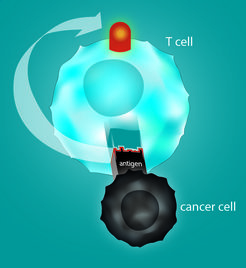The needle in the haystack

The immune system can fight specifically against cancer by tumor-specific T cells although suitable altered target structures are currently mostly unknown. A team at the the Max Planck Institute of Biochemistry and Technical University of Munich (TUM) has developed a method that allows for the first time the reliable identification of suitable antigens directly from patients` tumor cells by mass spectrometry. These structures proved to be immunogenic. This procedure therefore opens up new possibilities for individualized targeted cancer treatments.
Through evolution, the immune system has developed sophisticated mechanisms for fighting illnesses associated with viruses and tumors. T cells play an important role in this setting. They can identify peptides, small protein sturctures, presented by the body`s own cells that may indicate a viral infection or a genetic alteration as for example a mutation – a characteristic of tumor cells. Peptides identified by immune cells are known as antigens. T cells that recognize antigens can trigger a reaction that destroys the targeted cells. In recent years research teams, including TUM researchers, have successfully utilized this characteristic for cancer treatments. Different approaches have emerged. Vaccinating a patient with an antigen can stimulate the body to enhance the production of specific T cells. Another possibility is to enrich T cells that are "trained" for certain antigens and transfer them to the patient.
A method, that identifies the antigen structures of patient specific tumors has now been developed by a team led by Angela M. Krackhardt, a professor of translational immunotherapy at the Third Medical Clinic at TUM's Klinikum rechts der Isar, and Professor Matthias Mann of the Department of Proteomics and Signal Transduction at the Max Planck Institute of Biochemistry. Krackhardt and Mann have described their approach in an article published in the Journal Nature Communications. Unlike former applied methods, it is not based on predictive models. Instead, a mass spectrometer is used to identify the peptides actually present on the tumor surface.
